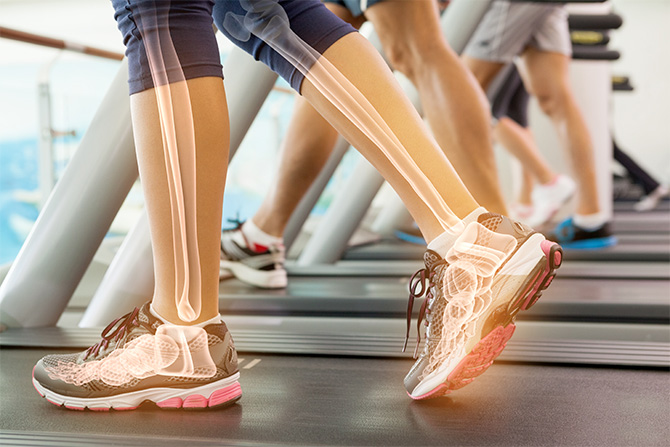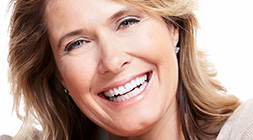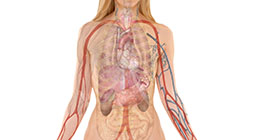
The bones of the human body are constantly being broken down and rebuilt. During childhood there is more bone being made than broken down. While most of the bone mass is already created at adulthood (age 18 to 20), it may continue to grow until age 30. After this, bone mass stays quite consistent until 40, after which it starts to gradually decline in both sexes. Once women go through menopause, the loss of bone density speeds up dramatically. The higher the bone mass is at its peak, the better protected the body is against declining bone health.
Osteoporosis, or “porous bone,” occurs when bone is broken down faster than it can be rebuilt. (See Osteoporosis.) It is estimated that one in four women and one in eight men have osteoporosis. Bone fracture is a dangerous result of osteoporosis. Many people who have hip fractures as a result of osteoporosis never leave long-term care facilities. Hip fractures may result in death in up to 20 percent of cases, with men being at a greater risk of succumbing to the injury.
Bone is a matrix that contains not just bone-building minerals but also collagen, which is the protein that makes bones strong and malleable. If bone health could be attained with a simple calcium supplement, there would be a reduction in the rates of osteoporosis as women are taking calcium supplements in record numbers. But osteoporosis rates remain high and there is clearly more to strong bones than just calcium.
Exercise for Strong Muscles and Strong Bones
Bone boosting nutrients are only part of the picture and supplementation alone will not ensure strong, healthy skeletal structure. Physical activity is also essential for lasting bone health. Like the muscles, bones become stronger when subjected to the stress of weight bearing or high impact exercise; and become weaker during periods of inactivity. Ideally, a person should be active throughout their whole life; however, beginning weight bearing exercises later in life may still be helpful in avoiding osteoporosis.
Not all exercise is equal when it comes to increasing bone mass. Some examples of high-impact exercise are:
- Dancing
- Jumping rope
- Running
- Tennis
- Hiking
The above may be too much for some people; walking or using equipment like a stair stepper or treadmill are beneficial for those to run or hike.
Strength training using free weights or weight machines will also help to improve bone health.
Exercises like yoga, qi gong, and tai chi are also important as they can increase flexibility and balance which helps to protect against falls. A study from the Journal of the American Geriatrics Society in 1996 reported a 47.5% reduction in the risk of falling after following a tai chi program for 15 weeks.
Bone-Building Nutrients
Vitamin D
Vitamin D is essential for calcium absorption and is formed in the body by the sun’s rays on the skin, which then manufactures vitamin D3. Unfortunately, because people are spending more time indoors, and are wearing more sun block, deficiencies in this nutrient have risen. It is especially common during the darker months of winter and for those living at northern latitudes. Vitamin D deficiency leads to decreased calcium absorption and increased excretion of calcium via the kidneys, promoting osteoporosis and other conditions such as osteoarthritis, muscle cramps and twitching, backache and tooth decay.
Few foods contain vitamin D naturally unless they have been fortified. However, a few types of fish contain some vitamin D. Wild salmon contains the highest amount, but it is also found in trout, Ahi tuna, and mackerel in lesser amounts. Small amounts may be obtained by eating eggs from chickens able to freely roam outside (free-range).
As the body ages it is less efficient at producing vitamin D, making vitamin D supplementation essential. In addition to being necessary for optimal bone health, vitamin D is important for muscle health as strong muscles help to prevent falls. It is important to choose a supplement with the most active and powerful form of vitamin D, which is vitamin D3.
Vitamin D3 Better than D2
A 2008 study conducted by the Department of Clinical Sciences at the University of Rome, found that a single dose of vitamin D3 was almost two times as potent as D2 in increasing serum levels.
A 2010 study in the Journal of Clinical Endocrinology and Metabolism reported that in 33 healthy adults taking 50,000 IU of either vitamin D2 or D3 weekly for 12 weeks, blood vitamin D levels increased significantly more in the D3 group than in the D2 group. This clearly shows that the two forms of vitamin D, D2 (ergocalciferol) and D3 (cholecalciferol), are not absorbed by the body in the same way.
Vitamin K2, MK-7 and Bone Health
Vitamin K2, another very important bone nutrient, guides calcium into bones and locks it in. Without enough vitamin K2, calcium may lodge in places that it is not supposed to, such as in the breasts, arteries and kidneys (leading to kidney stones). Calcification occurs which causes hardening of the arteries and contributes to high blood pressure and calcium deposits in the breasts.
The “K” in vitamin K comes from the German word Koagulationsvitamin, as it was noted by researchers in Germany that this group of vitamins was essential for blood coagulation. Vitamin K1 (phylloquinone) is a blood clotting agent and acts very differently than vitamin K2 (menaquinone). Calcium in the bones and arteries is regulated by vitamin K2. Vitamin K2 is associated with osteoblasts, cells that build bone and produce a protein called osteocalcin. Osteocalcin incorporates calcium into the bones. Without vitamin K2, osteocalcin cannot be produced in the body and proteins cannot bind onto calcium without enough vitamin K2. Vitamin K2 is therefore essential to help redirect calcium into bones.
Choosing the Right Type of Vitamin K2
Vitamin K2 (menaquinone MK-7) from natto is the best form of vitamin K2. Natto is a traditional Japanese food dish derived from fermented soybeans. Other sources of K2 include liver pâté from poultry, egg yolks and dark meat from pasture-raised chickens, and butter from grass-fed cows. Half of the vitamin K that the body absorbs is from green leafy vegetables (primarily K1). Unfortunately, many foods thought to be rich in vitamin K have less vitamin K than previously assumed. Most multivitamins don’t even contain vitamin K and those that do have subpar levels. To prevent and treat osteoporosis, supplement with Vitamin K2 MK-7.
Boron
Boron is a trace mineral that helps to prevent the loss of calcium and keep bone mineralized. It also helps to prevent vitamin D deficiency by extending how long vitamin D stays in the body. Boron regulates estrogen and testosterone, which is important for postmenopausal women and their bone health. Boron may be found in raisins, nuts, beans, lentils, and dates, as well as many fruits and vegetables.
Magnesium
Magnesium is needed to convert vitamin D into its active form and absorb calcium into the bones from the bloodstream. Without magnesium, calcium will remain circulating in the bloodstream until it ends up in places it should not be found, resulting in calcium deposits around the body. Taking too much calcium can actually hinder magnesium absorption and contribute to a magnesium deficiency. Consuming the right balance of each mineral is very important and can improve bone density. The best forms of magnesium are bisglycinate and threonate; magnesium citrate should be avoided unless using for a very short time to ease constipation as this form may cause mineral imbalances.
Collagen-Supporting Nutrients for Bone Support
Another important component for bones is collagen. Over one-quarter of all the protein in the body is made up of collagen. Collagen helps make bones, nails, teeth and hair stronger. Collagen connective tissues run throughout the body and provide structure for the skeleton, tendons, cartilage and muscles, all of which support internal organs and protect softer tissues. In order to make collagen, adequate levels of protein, silicon and vitamin C must be consumed.
Silicon is a trace mineral required by the body to make collagen. Specifically, silicon is converted into silicic acid which the body requires to manufacture collagen and elastin. Unfortunately, silicon from food and herbs is poorly absorbed, resulting in a lack of the building blocks required to make collagen. Silicic acid in supplement form, on the other hand, is used directly by the body to make collagen. Silicic acid is a fabulous bone booster. Receding gums are an early indicator of osteoporosis, and some dentists have reported that supplementing with silicic acid stops receding gums.
The Best Bone-Boosting Program
To build strong bones, exercise and combine an excellent calcium/magnesium supplement that contains the right forms of calcium such as aspartate, citrate, glycinate/bisglycinate, or threonate along with:
- Boron
- Collagen-building silicic acid
- Vitamin D3
- Vitamin K2 MK-7










